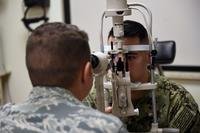In 1862, President Abraham Lincoln established a national veterans cemetery system to honorably bury those who died in service to their country. Before this system was established, soldiers were pretty much buried where they fell.
After the Civil War, the system was expanded to include veterans who hadn’t fallen in combat. Maintaining cemeteries that are more than 150 years old is no small task.
Today, the National Cemetery Administration (NCA) is the body under the Department of Veterans Affairs responsible for providing veterans and qualified dependents with a gravesite, grave liner, opening and closing of the grave, government marker, U.S. burial flag, Presidential Memorial Certificate and perpetual care of the site in “like new” conditions -- no matter how old the cemeteries may be.
But not all cemeteries, Soldiers’ and Airmen’s homes are created equal. At least, not yet. The NCA’s constant, continuing mandate is to ensure all of the final resting places under its care become national shrines. The VA defines a national shrine as:
“... a place of honor and memory that declares to the visitor or family member who views it that, within its majestic setting, each and every veteran may find a sense of serenity, historic sacrifice and nobility of purpose. Each visitor should depart feeling that the grounds, the gravesites and the environs of the national cemetery are a beautiful and awe-inspiring tribute to those who gave much to preserve our Nation’s freedom and way of life.”
The VA’s national shrine mandate holds that all national and other veterans cemeteries under the control of the NCA will be considered national shrines, but to do that, each must meet a meticulous set of 21 criteria.
Updated in 2016, the national shrine standards are intended for every cemetery and gravesite to become shrines by preserving the quality of the facilities, the historical context for monuments and cemeteries (even those overseas) and providing information on why those interred there gave their lives.
Once national shrine status is earned, it also must be maintained and checked with annual inspections from the NCA, which maintains 155 national cemeteries and 3.83 million graves as of 2021.
The original handbook of criteria that needs to be met for a VA cemetery to earn national shrine status was a list of regulations more than 30 pages long and covered everything from service scheduling, to verification and handling of remains, to how smoothly a recent burial is covered.
At least 15 of the VA’s national cemeteries have met national shrine standards, and two veteran cemeteries run by the Department of the Army have met them.
-- Blake Stilwell can be reached at blake.stilwell@military.com. He can also be found on Twitter @blakestilwell or on Facebook.
Want to Learn More About Military Life?
Whether you're thinking of joining the military, looking for post-military careers or keeping up with military life and benefits, Military.com has you covered. Subscribe to Military.com to have military news, updates and resources delivered directly to your inbox.











